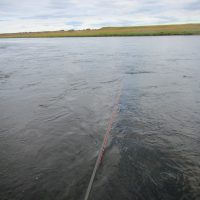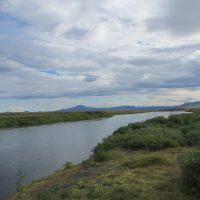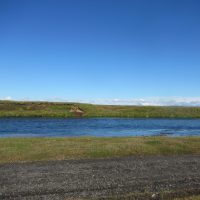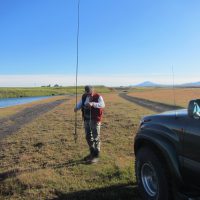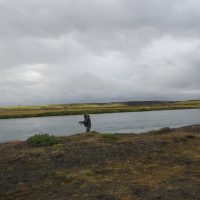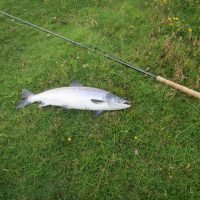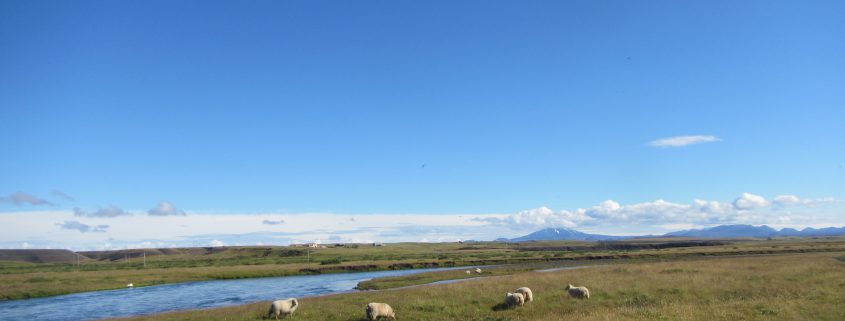
My fishing buddy Sibbi and I fished three different salmon rivers this summer. This post is about the first one, Eystri Rangá (Eastern Rangá (á = river). There are two Rangás, of which the eastern is smaller, with a steady flow of 30 cubic meters per second. It is mainly a spring-fed river. It holds salmon for about 22 km. Average early catch is around 4600 salmon with a generous portion of big fish. There are 9 beats with two rods, and you spend six hours on each beat. Anglers stay at a full-service lodge overlooking the river. There are 18 en-suite rooms. Guide service is provided and there is one guide per two rods on each beat.
http://www.ranga.is/veidisvaedi/eystri-ranga/upplysingar/
http://www.angling.is/en/waters/6369/
The East Rangá is about a one and a half hours drive from Reykjavik. It is a medium-size river flowing on the alluvial plain of Suðurland (South). The upper river is 15 to 25 m wide, broadening to 30 to 45 m on the lower beats. The beats are easily accessible by car (SUVs are better but no monster trucks are needed), and no strenuous hiking is necessary. There are no major rapids or waterfalls along it´s course, but the flow is quite swift and begs for swinging the fly. The bottom is good, sand or earth, with a few rocky areas. However, wading above knee level made me quite aware of the swift current.
The river at the top is flanked by a range of low, grassy hills. The river meanders over Beats 7 and 6 on the alluvial plain. Lower down on Beats 4 and 3 there are similarities to Tierra del Fuego, because of the grassland and winds!
This river is best suited to two-handed rods from (13 to 15´), with an intermediate or sink-tip # 8 to 10. Big flies and tubes seem to work best here. The fish are often deep, and the river is cold.
http://www.lax-a.net/iceland/salmon-fishing/salmon-full-service/east-ranga-river/
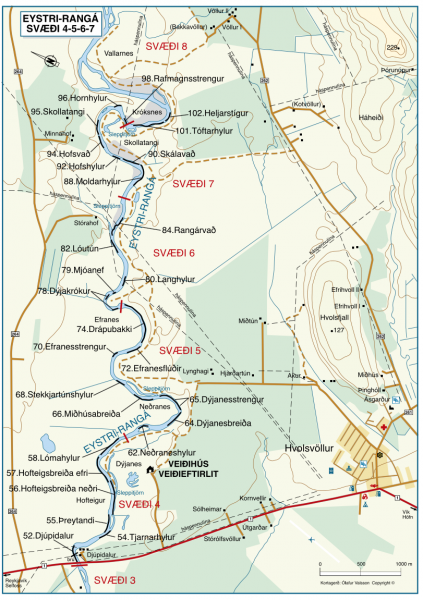
Beats 4, 5, 6, 7 Eystri Rangá
It was not a “natural” salmon habitat because of the cold water in it. The salmon were not able to spawn there in any numbers. There were at one time some Seatrout around (anadromous brown trout), but now they are mostly gone. The river was turned into a salmon river by growing salmon to the smolt stage. Then the smolt are released into the river. They will migrate to the estuary, and then into the ocean to reach sexual maturity, and return a year or two later to spawn.

Rangárvað (#84 refers to the # on the fishing chart) – cast to the other bank.
On a good day the vistas are great with the infamous volcano Hekla, and the ill reputed Eyjafjalla glacier, of flight delay fame, the main points.
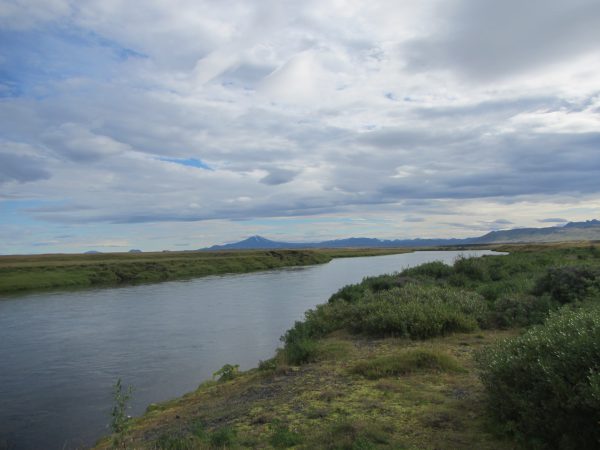
Hofteigsbreiða efri (#57, Hekla the volcano at center)
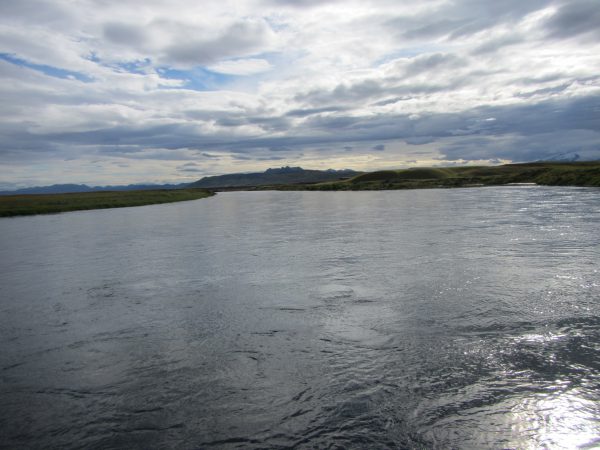
Big and broad (the glacier at the right edge is Eyjafjallajökull)
The current is rather heav,y and I wade up to my knees if I have to, but not more. By and large anglers wade far too much, and get too close to the fish. Practicing casting before the trip, especially with an instructor, will increase your catch rate much more than wading. This river is best fished with a two hander. The long two handed rods are known in Iceland, but mostly for overhead casts by the natives (well, the backcast is usually not a problem). Then they were used for steering earthworms into the gullets of salmon. I know it sounds terrible. but it is true. However, foreigners have always used the traditional Spey techniques with their two handers. It is a bit curious how the Spey casts faded from memory in Iceland because farmers (for instance in Aðaldalur in North Iceland) in the early 19oos were using long two handed rods with Spey technique. I hope Icelandic anglers are again catching on and will start using the two handed rod and maximize their advantage. Spey techniques can not be beat in close cramped situations with limited or no back cast available.
I have taken some two handed rod lessons here in Florida from the only certified two handed instructor in the whole state, Leslie Holmes ( http://leslieholmesflyfishing.com ), and have made some progress I think. At any rate I was rewarded with a beautiful salmon on Rangárvað (#84). I was fishing river left, and the fly was on the dangle. Then snap T placing the anchor upstream of me, and the subsequent roll casts to the opposite bank. The casts were working, and during a swing of a Snaelda everything just stopped, and it was on. First salmon I catch Spey casting. By convention you face downstream, and if the river is on your right you are on river left and vice versa. “Fly is on the dangle” means the fly is directly downstream of you close to your bank.
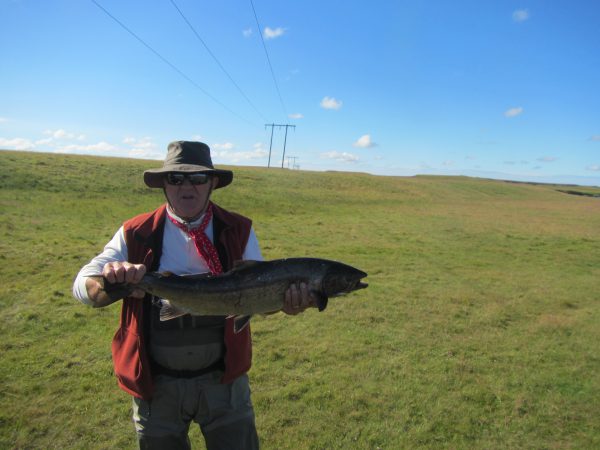
Salmon from Rangárvað
The look on my face holding the salmon is rather constipated (was not), but I can assure you I was very happy, as this picture proves.
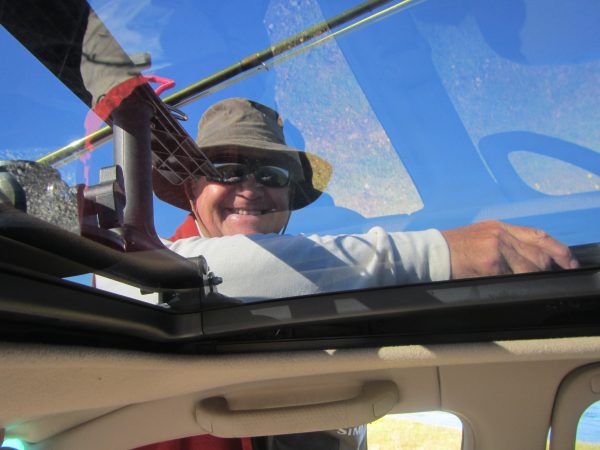
Happy
There are some places where the back cast is limited. Those are, of course, best worked using the traditional Spey casts. A case in point is the dark steep hill in the picture below. It begs for roll casts.
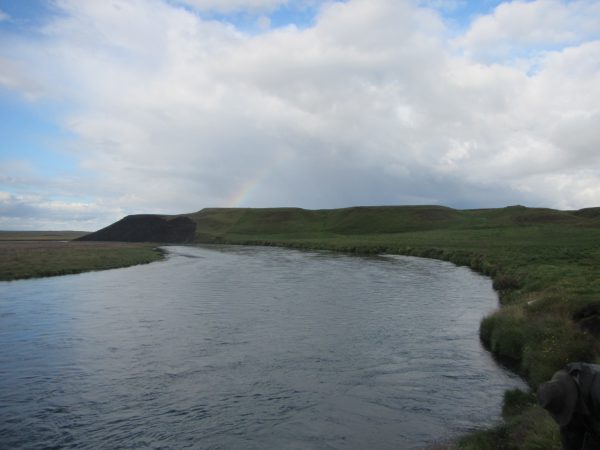
Dýjanesstrengur og -breiða (#65,64)
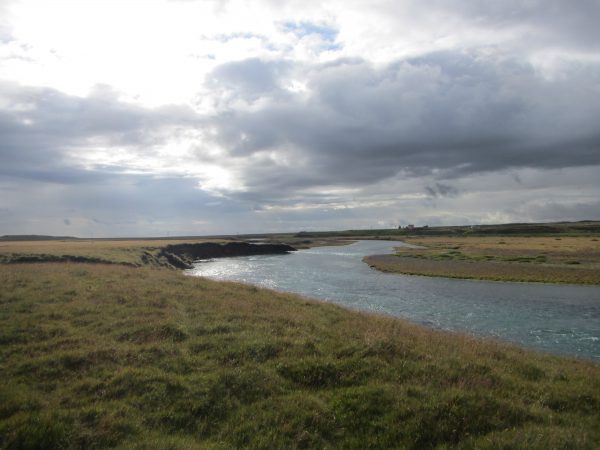
Langhylur (#80) The bank is a problem for overhead casting but no problem with a roll cast.
There are some very deep pools there, and in some places a sinking tip is good to have. Below I tried a Skagit set-up, and down it went, but the salmon were not interested.

Dýjanesbreiða (#64)
We fished beat seven, six, five and four. To fish all the beats you would spend nine days there. These beats had some very varied flow patterns, calling for different approches. We mostly fished these beats by the time honored tradition of swinging our flies. This means that one casts over to the opposite bank (or the opposite edge of a productive channel) and then the current grabs and swings the fly line and fly across to our bank. Sometimes we strip the fly a bit and experiment with the retrieve. We do not use microflies (#14-#16) here. This seems to be the river for tubes, and big is good. This was my first time fishing Eystri Rangá, so this should be read with that in mind. I will definitely return to this river given an opportunity. The days we were there the fishing was below average, but we managed to raise or catch salmon in every other pool we tried.
- Fourteen feet rod becomes small
- Hofteigsbreiða efri (#57, Hekla the volcano at center)
- A beautiful vista
- Rangárvað (#84)
- Rangárvað (#84)
- Lóutún (#82)
- Getting ready at Lóutún (#82)
- Lóutún (#82)
- Langhylur (#80)
- Lómahylur (#58)
- Salmon before release – Eystri Rangá

